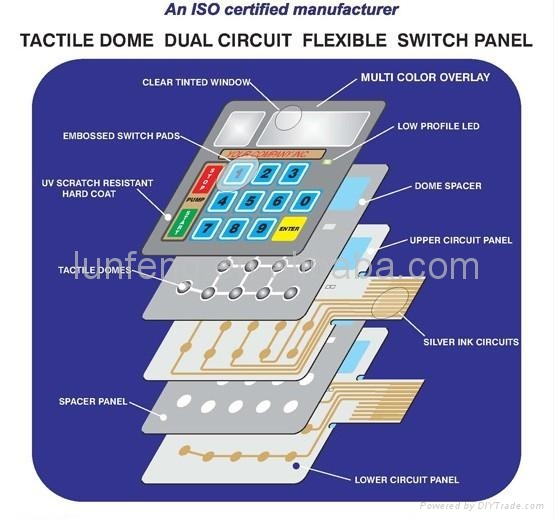Understanding Membrane Layer Switches: The Secret to Dependable and sturdy Controls

What Are Membrane Switches?
Membrane switches are a sophisticated solution in the realm of interface innovation, integrating capability and layout flawlessly. These gadgets act as an interface in between individuals and digital systems, incorporating a number of parts right into a compact style. Generally created from flexible, slim layers of products, membrane layer buttons are made to reply to touch, enabling users to communicate with machinery and digital tools properly.
The key components of a membrane layer switch include a printed circuit layer, graphic overlay, and a spacer layer that prevents unintended activation. The visuals overlay can be customized to show brand identity or customer choices, improving appearances while making sure use. Membrane layer switches are commonly utilized in numerous applications, including medical devices, customer electronics, and industrial tools, owing to their longevity and resistance to environmental factors such as dampness and dust.
One of the vital advantages of membrane switches is their ability to hold up against damage, making them optimal for high-traffic environments. In addition, they are lightweight and require minimal room, permitting innovative layouts in item growth. Generally, membrane switches over represent a reliable and functional option for modern digital interfaces, weding modern technology with user-centric style principles.
Exactly How Membrane Layer Changes Job
The operation of membrane switches over rest on a straightforward yet efficient device that translates individual input into electronic signals. These buttons include numerous layers, normally consisting of a graphic overlay, a spacer layer, and a circuit layer. When a customer presses the switch, the top layer flaws, allowing a conductive aspect in the circuit layer to make call with a matching conductive pad on the underside of the visuals overlay. This contact closes the circuit and sends a digital signal to the device, suggesting that the switch has been turned on.
The style of membrane layer buttons can differ, but they typically include domes or responsive elements to offer comments to the individual, boosting the total experience - membrane switch. The products utilized in membrane switches, such as polyester or polycarbonate, add to their sturdiness and resistance to environmental aspects, consisting of dampness and dirt. Additionally, the printed circuits are usually encapsulated, which safeguards them from deterioration with time.
Advantages of Membrane Layer Buttons

Furthermore, membrane switches are understood for their durability. Constructed from robust materials, they are resistant to dust, wetness, and physical wear, which substantially expands their life-span contrasted to traditional mechanical buttons. This longevity makes them specifically ideal for high-traffic environments and applications calling for long additional reading life.
Another significant advantage is the convenience of cleansing and upkeep. The smooth surface of membrane changes lessens dust accumulation and is typically invulnerable to spills, making them optimal for settings that require frequent sanitization.
Moreover, membrane layer buttons use a streamlined profile, causing a thinner style that can be incorporated right into different devices without including mass. This attribute not just improves the aesthetic appeal yet likewise adds to an extra ergonomic item layout.
Applications of Membrane Switches
Functional and straightforward, membrane switches locate applications across a wide variety of markets, including clinical tools, consumer electronics, and commercial equipment. In the clinical field, these buttons are indispensable to gadgets such as analysis devices, patient surveillance systems, and infusion pumps, where reliability and convenience of cleansing are vital. Their capacity to stand up to harsh settings and maintain capability makes them suitable for such applications.

In customer electronics, membrane layer switches are utilized in items like microwaves, washing devices, and remotes - membrane switch. Their sleek style enables user-friendly customer interfaces, enhancing the overall individual experience while giving sturdiness and resistance to deterioration
Commercial tools additionally benefits from membrane switches, particularly in control panels for equipment and automation systems. These switches supply security versus dust and wetness, making certain consistent performance in challenging atmospheres. Their personalized attributes enable makers to customize them to certain functional requirements, enhancing effectiveness and performance.
Choosing the Right Membrane Switch
When selecting a membrane layer switch, it is crucial to consider numerous variables that affect efficiency and suitability for certain applications. The key factors to consider consist of ecological problems, responsive comments, sturdiness, and layout specifications.
First, examine the operating atmosphere; switches exposed to dampness, chemicals, or severe temperature levels call for certain materials to ensure long life and performance. Next, assess the need for responsive comments. Depending on customer interaction, some applications might gain from a responsive feedback to verify activation, while others might choose a non-tactile design for visual reasons.
Sturdiness is another essential aspect; membrane buttons ought to be made to withstand constant use, impacts, and abrasion. Make sure the selected button can endure the anticipated lifecycle, specifically in high-usage scenarios.

Conclusion
In conclusion, membrane switches over serve as vital components in the style of sturdy and trustworthy control systems throughout numerous industries. The versatility of membrane layer switches enables for tailored remedies that meet particular operational demands, reinforcing their importance in contemporary innovation.
Membrane layer switches over stand for a crucial aspect of modern-day user interface style, mixing functionality with resilience in different applications.Membrane layer switches are helpful site an advanced service next page in the realm of individual interface innovation, integrating performance and style seamlessly. Typically built from versatile, thin layers of products, membrane layer buttons are created to respond to touch, enabling users to interact with equipment and digital gadgets successfully.
The style of membrane buttons can differ, however they typically integrate domes or tactile elements to provide responses to the customer, improving the general experience.In final thought, membrane switches over offer as necessary elements in the design of dependable and resilient control systems across numerous markets.